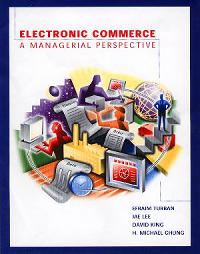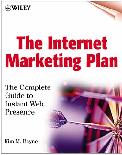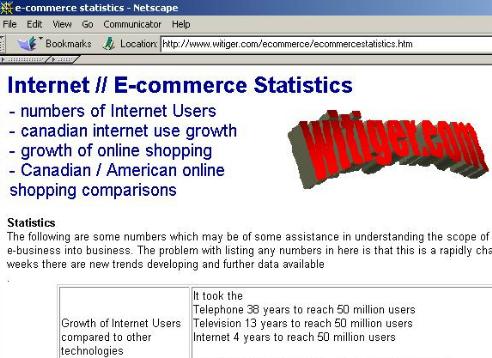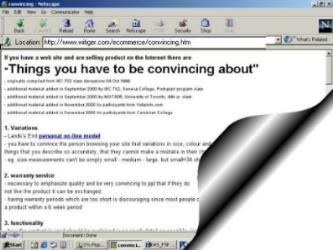
 |
MGTD06 |
| Marketing in the Information Age | |
| 4rth year course in the Division of Management, University of Toronto at Scarborough, Canada |
| Section A | Section B | Section C | Section D | Section E |
| Fundamentals within which Marketing in the Information Age takes place | 1.
The 4P's - things you can control
2. The the 5 (6) environments - things you cannot control, but, which effect you |


Chapter 1 |
The Driving forces (or
the 5 Environments effecting e-Business)
(1st. ed. p. 19) (2nd ed. p. 17, 18) Text saysThe Standard Marketing Terms are
|

Chapter 1 |
Managerial Issues
(2nd ed. p. 29-30)
|
 |
Cyber Rules by Tom Siebel
( http://www.siebel.com/) published
in April of 1999 is not a textbook but it is a thought provoking
collection of essays on the whole internet/e-commerce community.
Siebel has an excellent grasp of the key issues and even if
you only read the first 2 chapters, it is worth buying the book.
Amazon has it as do many others. There are many quotable
quotes from this book which we will use in the intro to IEC
702
The foreward to Seibel's
book was penned by "the" Charles Schwab.
"... the internet effects
literally everything about the way we do business, and, as such, impacts
all our lives ... yet this transformation will only happen for companies
that focus on service to the individual customer ... at the heart of E-business
growth is an interesting paradox .. E-business has been built by technology,
but it's not about technology ... enabled by technology, but not changed
by it"
Seibel follows this foreward
with equally intense prose stating that
|
Chpt 3
 |
"Most typical marketing
plans quote applicable market statistics ... market statistics are important
because they outline, in general and in detail, what the market is all
about. Statistics can make or break your company's decision to participate"
Kim Bayne Chpt 3, page 53 Do You Really Need Internet
Statistics? page 54.
|
 |
Some new info has been added
- and all the stats related info is under one heading
Witiger
|
| Who and
what is e-commerce In this
|
#1 link to the text of what we discussed in class today - important to review essentially we discussed what understandings you need to have to successfully e-tail to 21~34 yr olds http://www.witiger.com/ecommerce/views.htm This page "views.htm" is
a work in progress and something we will further build on in this class
read Teens Increase Online Shopping More than 10 million US teenagers will make a purchase online by the year 2002, a dramatic increase from the estimated 2 million teens that shopped online in 1998 http://people.senecac.on.ca/tim.richardson/articles/teensonline.htm |
Chpt 3
 |
Organizations and Associations
and Trade Magazines
"Many marketing and industry
specific associations offer their members reports, white papers, and research
papers on trends in new media".
|
| Cyber
Shopping |
Kelly Mooney - Cyber Shopper
http://www.fastcompany.com/nc/001/024.html Mooney converted her findings into a personal, opinionated Internet-shopping audit: E-Commerce Analyst Watch 2.0. What can we learn about her list of do's and dont's 1. first, do we agree with her do's and dont's 2. what can we apply from the list to clients and employers you may be working with 3. Our list of Do's and Don'ts http://www.witiger.com/ecommerce/dodonot.htm
Mooney's chart is available to view on-line at http://www.fastcompany.com/nc/images/bigchart.jpg - just because it's on the Net, "don't make it so" - what is there about the chart that is useful?, and what could be explained better? Paul Graham's "The 10 Secrets of Selling Online" http://store.yahoo.com/vw/secrets.html |
| E-tailing
Considerations |
Canadians from Purchasing on the Internet
Source: Ernst & Young
(January, 2000 )as used by Substance Consulting
|
| E-tailing
Considerations "Security Major Concern" hmmmm |
"Canadians Leery of online Shopping" Daly uses a poll by Leger Marketing to support a conclusion that "most Canadians remained wary of online shopping despite the glowing prediction of mass success when electronic commerce first began". "Internet users accounted for 60% of Canada's population but 51% of the users pooled said they hadn't shopped or bought anything online in the past year, and weren't planning to do so in the future" "Of the survey respondents who hadn't made any online purchases in the previous four weeks, 46% said it was because they didn't want to give out credit card details" ? - who is Leger Marketing www.legermarketing.com they have a kewl flash website - but it is hard to navigate to find out specifics of what they do, other than just about everythig to do with marketing - there is not clear reference to any specific e-business capability nor could witiger find anything on the site about any surveys they did |
| E-tailing
Considerations "Things you have to
|
Source: Ernst & Young
(January, 2000 ) as used by Substance Consulting
|
| "Things you
have to be convincing about" E-tailing
"Things you
"Things you
|
List
of things you have to be convincing about

http://www.witiger.com/ecommerce/convincing.htm Most of this class will be spent discussing the "convincing.htm" list and adding on to it. 1. Variations
|


Chapter 2 |
|

Chapter 2 |
Potential Winners and Losers
in E-Business
(2nd ed. p. 65-66) Winners
|

Chapter 2 |
Impacts on Business Process
and Organizations
(2nd ed. p. 67-73)
|
| possibly, we might have
time to see a short video from the CBC program, Venture
- if not, the program is on their web site you can also go here to look
at other Venture programs and the accompanying text
Points for consideration, why did Chapters web site cost them $22 million and why did they have to hire 130 people What are these costs?
+ another $10 million for a new warehouse to house all the books to be mailed out |
the link below will take
you to a text summary of the main points in the program
featured
|
|
|
CONTACT IMAIN PAGE I NEWS GALLERY I E-BIZ SHORTCUTS I INT'L BIZ SHORTCUTS I MKTG&BUSINESS SHORTCUTS I TEACHING SCHEDULE |
| . | |
| MISTAKES I TEXTS USED I IMAGES I RANK I FORMER STUDENTS I | |
| . |